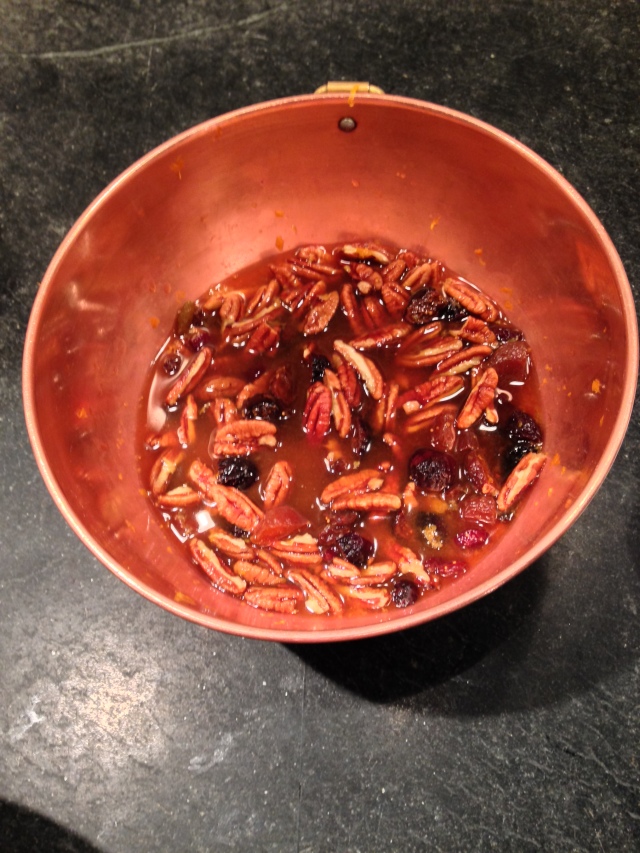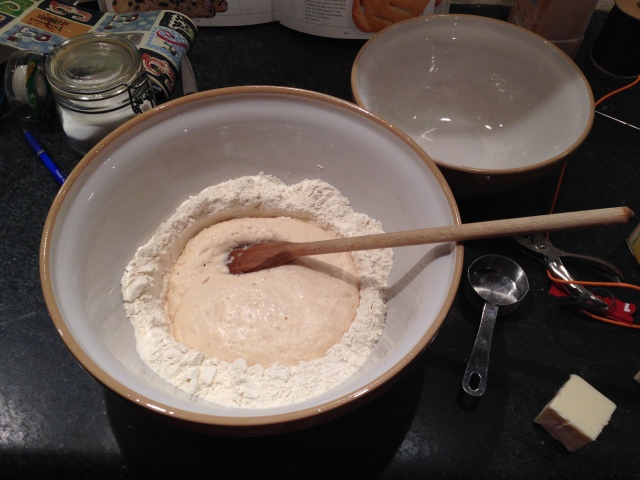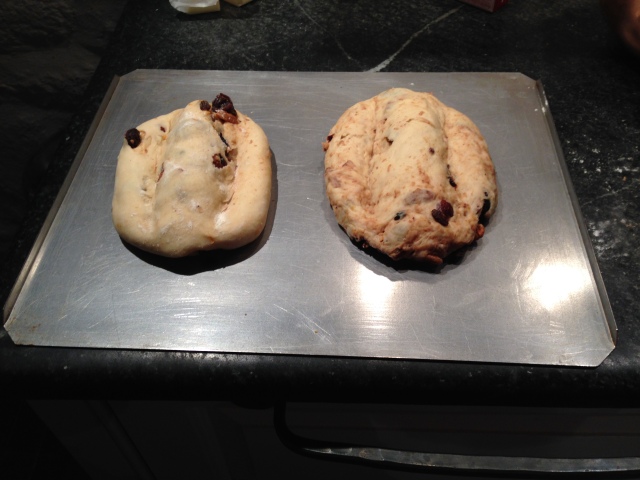Henry’s guest post – Stollen
Baking is a highlight for me during the Christmas holidays. Baking is not only appetizing, but it also brings back memories of past Christmases. Sugar cookies and lebkuchen have been eaten during the holidays in my family for as long as I can remember, and I am sure well before I was born. Recently, as an addition to our other holiday treats, I have been baking Christstollen.
Christstollen is a traditional German holiday pastry. Christstollen, or simply “stollen,” originated in Saxony during the late medieval ages. The original recipe was very different from its modern derivatives. Today’s stolen is famous for its sugary topping and butter enriched taste. The first stollens, however, were probably rather bland as baking with butter was forbidden during Advent. Instead of using butter, bakers had to use oil as a substitute, which, although probably good for everyone’s cholesterol, made for a pretty bland pastry.
The royalty of Saxony found this to be such a drag that they petitioned the Pope for an exception. After 40 years of petitioning, and 5 dead Popes, the Prince-Elector of Saxony got to have butter in his stollen (although everyone else still had to pay a fine to the Catholic Church for using butter). After the Protestant reformation, the fine was abolished. The major change of ingredients, from oil to butter, in stollen is due mostly to abolishment of that fine.
Stollen is traditionally shaped in such a way to imitate the baby Jesus in swaddling clothing. This generally makes for a very odd looking pastry, but is a great excuse to cover the pastry in confectionary sugar for authenticity. You will notice in the pictures that I avoided doing this. Using confectionary sugar is traditional and tasty, but it is messy. Considering how this pair of stollen turned out, I decided against topping the pastries with sugar. In the list of ingredients I’ve included everything needed for a fairly traditional stollen recipe.
Stollen
Ingredients
1¼ packed cups of raisins (mix of black and white)
¾ cup dried dried cranberries
¾ cup mixed dried figs and apricots, chopped
¾ cup pecans
grated zest of two lemons
½ tsp ground cardamom
¼ tsp nutmeg
dash of black pepper
½ tsp vanilla
3 tbsp dark rum or brandy
6 tsp dry yeast
1 cup warm milk
3 ¾ bread flour
1 ½ tsp salt
½ cup sugar
10 tbsp unsalted butter, softened
confectioners’ sugar
Directions
I.
In a bowl combine raisins, cranberries, dried figs, dried apricots, and pecans. Add spices, vanilla, and rum. Try to submerge everything with rum, if 3 tbsp is not enough rum, add more. Soak for 2 hours.
-If you decide to soak for longer than 2 hours, do not soak the nuts as they will become soggy.
II.
Warm the milk, but not too much. The yeast will not activate in milk that is too cold, but it will die in milk that is too warm. If you place your finger in the milk and it hurts, it is too hot for the yeast. If you are a perfectionist, around 100-105F° should be just right. Dissolve the yeast in the milk, and let stand until it begins to foam.
-If it does not do this, your yeast is probably too old, the milk is too cold, or you burned the yeast to death.
III.
Combine the flour and salt in a bowl and move the mixture to the sides to form a hole. Into this hole pour the milk and dissolved yeast. Stir in enough flour to form a paste. The paste should be more on the side of a solid than a liquid, but still very moist. Cover the bowl and let the mixture rise for at least 20 minutes. Next add the sugar and butter, and mix the dough altogether. Now cover the bowl again and let rise for around 1½ hours, or until doubled in size.
-Sometimes the dough hardly seems to rise at all. Do not worry, your pastry may be smaller than usual, but it will still be good.
IV.
Lightly flour a work surface and begin kneading the dough. Continue to knead the dough until its texture is even, and when you press against the surface of the dough it bounces back a bit.
V.
Flatten the dough into a square about as thick as the width of your thumb. After draining the dried fruits, and nuts, sprinkle them onto the dough, and begin kneading them in. I generally pull one side of the dough over the other, and then flatten the dough out again before adding more fruits and nuts.
-This can get rather sticky and messy. You may not be able to get all the fruits and nuts incorporated. Remember that dried fruit that is left on the surface of the pastry will burn in the oven. It will be almost impossible to not have some fruit poking through the dough, but limit it as best you can.
VI.
Form the dough into about a 14 inch and 1 inch thick shape. Its width will depend a lot on how well it rose, but do not worry too much about exact measurements. Place the dough on a buttered baking sheet. Now you mold the dough to imitate swaddling. I generally make a large ridge down the center of dough with my hands, but you could fold and flatten the dough if you find that works better for you.
VII.
Bake at 350 F° for 1 ½ hours until firm, and when pierced clean by a skewer or knife. You may want to cover the dough with a sheet of tin foil if you find its surface is browning too much.
VIII.
Cool on a rack. This is a great time to melt some butter on the surface, and cover the pastry with confectioners’ sugar. This is fun and tasty, but if you decide not to the pastry will still be delicious, even if it is not traditional.
This recipe is adapted from a recipe in DK’s Bread, Artisan Breads from Baguettes and Bagels to Focaccia and Brioche, by Eric Treille & Ursula Ferrigno.






